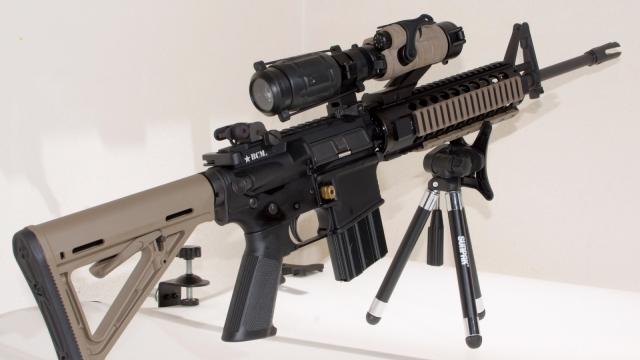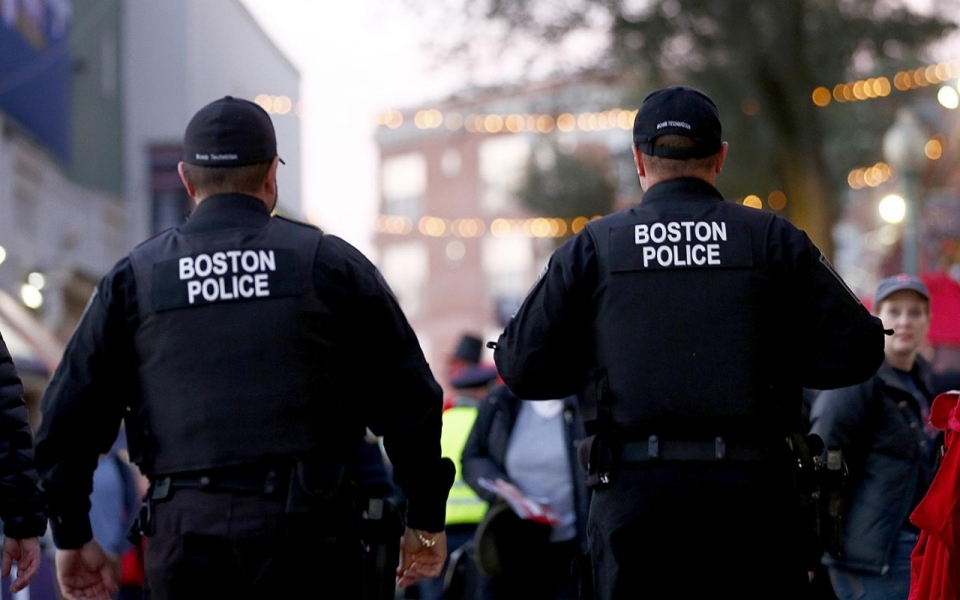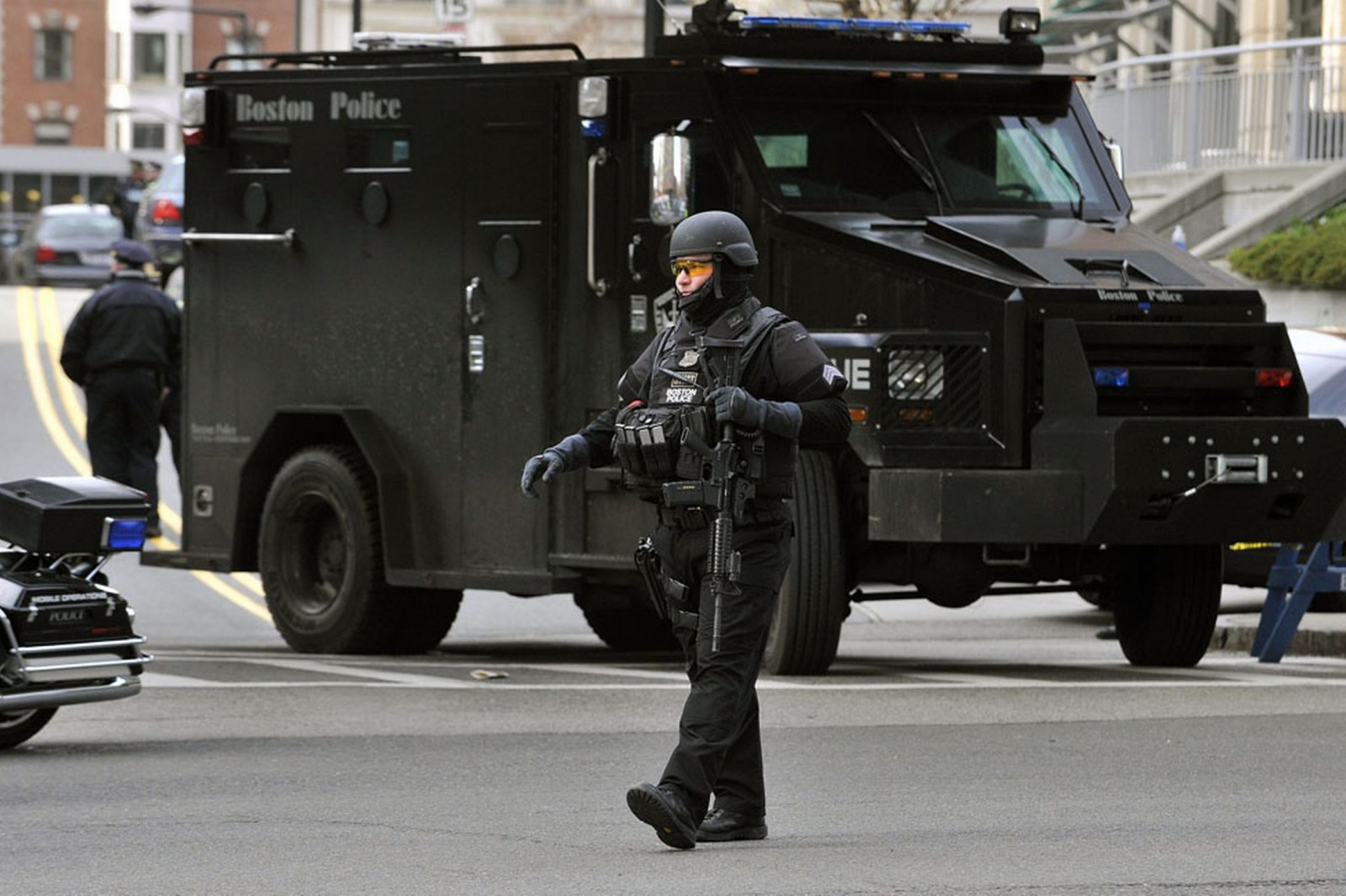
BOSTON — Standing several blocks from the scene of a recent shooting in Boston’s Roxbury neighborhood, Tariq Nazyat recalled the days when gun violence in the area was far worse than it is today. And he would know: He once carried a gun and shot someone before being sent to prison.
“I’ve been shot, I’ve been stabbed,” said Nazyat, 39, now a machinist and father who credited “good people” with helping him turn his life around. “That was that life back then. I was scared.”
But gun violence in the neighborhood has declined sharply since his teenage years, so he was puzzled by Boston Police Department plans to buy about 30 military-style semiautomatic rifles and train nearly 100 patrol officers to use them.
“Everybody’s seen shootings, but not like before,” said Nazyat, who wore a black Boston Celtics baseball hat and matching jacket, referring to Roxbury residents.
The plans to deploy the powerful weapons have triggered a major debate in New England’s largest city. On the one hand, many residents, especially in neighborhoods dominated by minorities, worry about a creeping militarization of their local police force, fearing that deploying such rifles on the streets could create more dangers than they solve.
Some security analysts agree, seeing the move as part of a larger shift toward the militarization of police departments that has been happening in the rest of Massachusetts and across the country.
But on the other hand, the police and their supporters see a real need to combat often heavily armed criminals and prepare for terrorist threats, as in the case of the city’s recently targeted marathon. Police say they need the guns to do their jobs effectively and protect the city and its people.
Boston Police superintendent Kenneth Fong said police “routinely” seize semiautomatic assault rifles from the streets. They need the high-powered AR-15-style rifles, he said, to contend with “active shooter-type situations” and suspects who may be clad in body armor, heavily armed or beyond the range of handguns.
“The city and the world we live in now is different than in years past,” he said, “and we need to have equipment to meet the threat that we’re facing now.”
Planned Before Bombings
On April 15 — when two bombs exploded at the Boston Marathon, killing three people and injuring more than 260 — the plan to buy the rifles was already in the works. But the attack and its aftermath, including an extensive manhunt by heavily armed police, highlighted “a situation where we didn’t have a sufficient number of officers properly equipped,” Fong said.
Edward Davis, who recently stepped down as the city’s police commissioner, proposed the idea in 2007.
“There was some hesitance to move forward with it at that time,” Davis told Al Jazeera. “I think that it’s appropriate that it’s starting back up again.”
Two years later, Boston police ordered about 200 semiautomatic M16s from the U.S. military under a federal surplus program and planned to distribute them to neighborhood officers before Mayor Thomas Menino thwarted the plan, the Boston Globe reported at the time. But some 82 police departments elsewhere in Massachusetts, many facing little or no violent crime but fearing terrorist attacks, have obtained more than 1,000 such weapons.
Menino, who will leave office at the end of year, has pressed for stricter gun legislation in Massachusetts. He was “well aware” that such rifles were common in other jurisdictions, and he “will continue to advocate for the limited use of these weapons for routine work,” Menino’s spokesman John Guilfoil said in an email to Al Jazeera.
“The mayor made clear that he doesn’t expect these types of weapons to be used regularly but rather stored securely in police vehicles and used only during necessary emergency situations,” Guilfoil added.
Even within the Boston Police Department, some officers favored an expansion of the current model of deploying tactical vehicles and trained specialists rather than arming ordinary patrol officers with semiautomatic rifles.
“All of a sudden the department seems to be rushing into this,” said Jack Kervin, president of the Boston Police Superior Officers Federation labor union. “It isn’t like this is Fallujah or we’re in a war zone.” ‘Standard police weapon’?
Under the current plan, the department expects to equip two officers in each of the city’s 11 districts with the long-range AR-15 rifles, which would be kept in cruisers, Fong said.
The weapons would add to the firepower of a department that has four to eight specially trained officers who patrol the city in so-called tactical vehicles, each equipped with an M4 rifle and a shotgun.
“Mainly it’s to give officers facing suspects armed with heavy weapons the ability to be able to respond to them,” Fong said.
The AR-15 has become “a standard police weapon,” said Robert Cottrol, a professor at George Washington University Law School.
“Not that every police car has one, but most police departments have a stock of them, so if there is a situation that calls for it, you can call for people with AR-15s,” Cottrol said. “That’s fairly common, and I think that makes perfect sense.”
Ladd Everitt, director of communications for the Coalition to Stop Gun Violence, an advocacy group based in Washington, D.C., said police need the guns because they were facing similarly armed suspects on the streets.
“We’re seeing more police arming themselves up with assault rifles, essentially battlefield rifles, and it’s sad,” he said. “It’s the escalation of violence between essentially law enforcement and the average civilian.”
Some analysts fear such weapons could be used routinely. Although they may have been bought for extraordinary circumstances, “suddenly after a few years we find them being incorporated into drug raids, which happen on a more regular basis,” said Tim Lynch, criminal-justice project director at the Cato Institute, a libertarian think tank.
“The most disturbing repercussion that we see happening is when officers are dressing up in military garb, camouflage uniforms, military boots and helmets, and now you put M16s in their hands, there’s just a subtle change in their whole mentality when it comes to policing,” he said. “They begin to view the people in the community as adversaries, as the enemy, instead of people who have constitutional rights.”
He cited violent no-knock raids by police and the use of flash-bang grenades, among other tactics, often undertaken without preliminary investigation, he said.
“It’s just a recipe for unnecessary violence and unnecessary injuries and sometimes the loss of life,” Lynch said. “The idea that your average patrolman in the neighborhood is going to be attacked by someone with an AK-47 — that’s just speculative fears rather than real evidence of them being outgunned.”
Paramilitarization of Police
In Massachusetts, shootings have increased in Boston in recent months but remain far lower than they were in the early 1990s. The state has among the lowest rates of gun-related deaths in the country and some of the nation’s toughest gun laws, according to the Journal of the American Medical Association. Most shootings are committed with handguns.
Kade Crockford, director of the Technology for Liberty Project at the American Civil Liberties Union of Massachusetts, said the move reflects a trend nationwide that includes the “paramilitarization of the police” and the federalization of local and state police departments.
She referred to fusion centers established by the U.S. Department of Homeland Security that conduct surveillance and are run by state and local police but staffed by National Guard, military, FBI and other federal personnel, with access to real-time surveillance feeds and public and private databases.
“Do we want police officers who are sent out into our streets to be trained as if — and equipped as if — the people they encounter on their patrols are enemy hostile targets, as if in a war?” she said. “Or do we want them to see people in our communities as allies and people they are meant to protect and serve?”
On the street in Roxbury, Tariq Nazyat disputed the assertion that police were routinely confiscating assault rifles, saying most young people with guns in the neighborhood probably had 40-year-old Browning pistols.
“What do you need an AR-15 for?” he asked. “We’re in the middle of the city. If you open that gun up in the middle of the city, chances are somebody’s going to get hurt. I don’t really think you should be in that line of work if you even have that type of mentality.”
3 WAYS TO SHOW YOUR SUPPORT
- Log in to post comments















